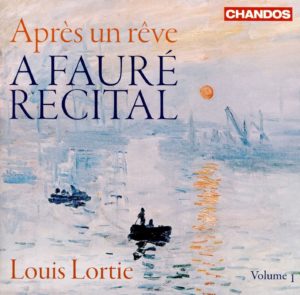Is it really true that Fauré’s piano music is too intimately scaled and harmonically refined to make an impact in large halls? Louis Lortie’s first volume in what promises to be a complete Fauré cycle suggests otherwise. The pianist employs a wider range of dynamics to the music than others, and inflects the melodies with songful force. Chandos’ reverberant sonics underline these traits, along with the bristling clarity of the Fazzioli concert grand’s high register that differs from the rounder, more uniform timbral characterstics of the Steinway used throughout Kathryn Stott’s Hyperion Fauré cycle. And in contrast to Fauré recordings that lump works together by genre (the complete Barcarolles, the complete Nocturnes, etc.), Lortie deftly mixes and matches original works with effective transcriptions of the composer’s more familiar songs and orchestral fare.
The opening selection, Lortie’s transluscent piano version of the Pavane, makes for a tuneful bridge into the Fifth Barcarolle’s more elusive phraseology, while the Sixth Barcarolle’s airy, extroverted flourishes contrast to the lyrical melancholy of following selection, the Fauré/Grainger Après un rêve.
Lortie gives a meticulously detailed reading of Maurice Maeterlinck’s transcription of the Pelléas et Mélisande Suite. Admittedly the sustained string writing in the final movement depicting Mélisande’s death loses something in translation via the piano, yet Lortie keeps Fileuse’s big chords and perpetually spinning line texturally distinct and rhythmically alive. If Stott approaches the Barcarolles and Nocturnes like a watercolorist who revels in fleeting nuance and momentary felicities, Lortie aims for greater animation and longer, sweeping lines that still take the music’s contrapuntal and harmonic subtleties into insightful account.
This also applies to the remarkable and often overlooked Nine Preludes Op. 103. In the first Prelude, for example, Stott leisurely floats the right-hand cantabile into the foreground, while Lortie’s stronger left-hand presence brings out the accompaniment’s jarring dissonances. Lortie makes a virtuosic tour-de-force out of No. 2’s rapid triplet figurations, but Stott’s slower tempo enables their hidden melodies to emerge. Lortie shapes No. 4 in broad brush strokes, while Stott’s relatively cameo-like interpretation has more varied articulation. Lortie imbues No. 8’s repeated notes with a sparkling, étude-oriented attitude that contrasts to Stott’s more sedate and conversational conception.
Roger Nichols contributes excellent and scholarly annotations. Indeed, the only unattractive element about this release is the close-up photo of Lortie on the back of the booklet, with his hands positioned as if he’s about to wring your neck.
































